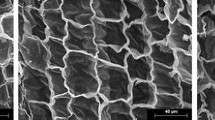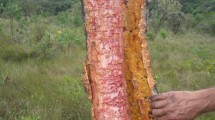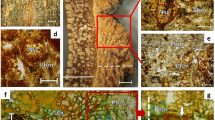Abstract
Agonandra brasiliensis, ivory wood, is a tree species from the Brazilian cerrado with a bark featuring a thick cork layer. The present study aimed to describe the cellular features and chemical composition of this cork. The cork was investigated regarding cellular structure and biometry, as well as summative chemical composition. The results were compared with those of corks from Quercus suber, as a reference commercial cork, and Kielmeyera coriacea and Plathymenia reticulata, which are native Cerrado cork species. The periderm of A. brasiliensis develops continuously around the stem with a thick cork layer. The cork has the typical characteristics of cork tissues with a compact structure of prismatic cells, stacked base to base in the radial direction without intercellular spaces. Cell walls were heavily corrugated and growth rings were present with a distinction of earlycork and latecork cells. A. brasiliensis cork cells are larger (49.1 µm prism height and 5.5 × 10–5 cm2 base area) than those from the reference Quercus suber cork, the number of cells per unit volume is smaller as well as the fraction of solid volume (7.6%), contributing to a lower density of cork. Chemically A. brasiliensis cork is characterized by a low suberin content of 5.6%, and a high lignin content of 45.5%, and includes 13.6% extractives. The ethanol–water extracts have low phenolic content and weak antioxidant activity. The cork of A. brasiliensis differs considerably from those of Q. suber, P. reticulata and K. coriacea, namely regarding its suberization level, which will impact the mechanical properties and limit the range of commercial applications, that should be directed towards insulation and low-density products.







Similar content being viewed by others
References
Almeida YM, Mendonça MCR, Fonteles MC, Matos FJA (1985) Avaliação da qualidade moluscicida de 32 plantas do Nordeste brasileiro [Avaliation of malluscocidal activity from 32 native plants of the Norhteast of Brazil]. Rev Med Univ Fed Cear 25:71–79
Alonso AA, Machado S (2008) Stem protective tissue in Erythroxylum tortuosum (Erythroxylaceae), a fire tolerant species from cerrado. IAWA J 29:69–77. https://doi.org/10.1163/22941932-90000171
APCOR (2015) Anuário de cortiça 2015 [Cork Yearbook 2015]. Associação Portuguesa da Cortiça, Santa Maria de Lamas
Appezzato-da-Glória B, Carmello-Guerreiro SM (2012) Anatomia vegetal [Plant anatomy], 3rd edn. Editora UFV, Viçosa
Aroso IM, Araújo AR, Fernandes JP, Santos T, Batista MT, Pires RA, Mano JF, Reis RL (2017) Hydroalcoholic extracts from the bark of Quercus suber L. (Cork): optimization of extraction conditions, chemical composition and antioxidant potential. Wood Sci Technol 51(4):855–872. https://doi.org/10.1007/s00226-017-0904-y
Cadahía E, Conde E, Fernández de Simón B, García-Vallejo MC (1998) Changes in tannic composition of reproduction cork Quercus suber throughout industrial processing. J Agric Food Chem 46(6):2332–2336. https://doi.org/10.1021/jf9709360
Campos Filho EM, Sartorelli PAR (2015) Guia de árvores com valor econômico [Guide to trees with economic value]. Agroicone, São Paulo
Cardoso S, Ferreira J, Miranda I, Pereira H (2018) Age variation of Douglas-fir bark chemical composition. J Wood Chem Technol 38:385–396. https://doi.org/10.1080/02773813.2018.1513036
Carvalho PER (2010) Espécies arbóreas brasileiras [Brazilian tree species] 2 edn, vol 2. Embrapa Florestas, Colombo
Conde E, Cadahía E, García-Vallejo MC, Fernández de Simón B (1998) Polyphenolic composition of Quercus suber cork from different Spanish provenances. J Agric Food Chem 46(8):3166–3171. https://doi.org/10.1021/jf970863k
Ferreira JPA, Miranda I, Gominho J, Pereira H (2015) Selective fractioning of Pseudotsuga menziesii bark and chemical characterization in view of an integrated valorization. Ind Crop Prod 74:998–1007. https://doi.org/10.1016/j.indcrop.2015.05.065
Ferreira JP, Quilhó T, Pereira H (2016a) Characterization of Betula pendula outer bark regarding cork and phloem components at chemical and structural levels in view of biorefinery integration. J Wood Chem Technol. https://doi.org/10.1080/02773813.2016.1224248
Ferreira J, Miranda I, Şen U, Pereira H (2016b) Chemical and cellular features of virgin and reproduction cork from Quercus variabilis. Ind Crop Prod 94:638–649. https://doi.org/10.1016/j.indcrop.2016.09.038
Fortes MA, Rosa ME, Pereira H (2004) A Cortiça [The cork], 2nd edn. IST Press, Lisboa
Goulart LS, Teles HL, Mendes VA, Vieira MCS, Moura SV, Ramon JL, Souza JM, Vieira JCS, Campos EP (2013) Prospecção antifúngica em Agonandra brasiliensis [Antifungal prospecting in Agonandra brasiliensis]. Ver Bras Farm 94:289–294
Hiepko P (2000) Opiliaceae. Flora Neotrop 82, 1–53. http://www.jstor.org/stable/4393902. Accessed 2 Jul 2020
Hiepko P (2008) Opiliaceae. Conservatoire et Jardin botaniques de la Ville de Geneve Geneve. https://nla.gov.au/nla.cat-vn5249170. Accessed 2 Jul 2020
Knapic S, Oliveira V, Machado JS, Pereira H (2016) Cork as a building material: a review. Eur J Wood Prod. 74:775–791. https://doi.org/10.1007/s00107-016-1076-4
Koek-Noorman J, Rijckevorsel P (1983) Wood and leaf anatomy of Opiliaceae. Willdenowia 13:147–174. https://www.jstor.org/stable/3995991
Leite C, Pereira H (2017) Cork-containing barks—a review. Front Mater 3:63. https://doi.org/10.3389/fmats.2016.00063
Marquete R (2005) Reserva ecológica do IBGE—Opiliaceae [IBGE ecological reserve—Opiliaceae]. Rodriguésia 56(87):133–139. www.jstor.org/stable/23498268. Accessed 8 Nov 2018
Miranda I, Gominho J, Pereira H (2013) Cellular structure and chemical composition of cork from the Chinese cork oak (Quercus variabilis). J Wood Sci 59:1–9. https://doi.org/10.1007/s10086-012-1300-8
Mota GS, Sartori CJ, Ferreira J, Miranda I, Quilhó T, Mori FA, Pereira H (2016) Cellular structure and chemical composition of cork from Plathymenia reticulata occurring in the Brazilian Cerrado. Ind Crop Prod 90:65–75. https://doi.org/10.1016/j.indcrop.2016.06.014
Oliveira V, Rosa ME, Pereira H (2014) Variability of the compression properties of cork. Wood Sci Technol 48:937–948. https://doi.org/10.1007/s00226-014-0651-2
Opiliaceae. Flora do Brasil (2020) Jardim Botânico do Rio de Janeiro [Flora do Brazil (2020) Botanical Garden of Rio de Janeiro]. http://floradobrasil.jbrj.gov.br/reflora/floradobrasil/FB19966. Accessed 8 Nov 2019
Pereira H (1988a) Chemical composition and variability of cork from Quercus suber L. Wood Sci Technol 22(3):211–218. https://doi.org/10.1007/BF0038601
Pereira H (1988b) Structure and chemical composition of cork from Calotropis procera (Ait.) R. BR. IAWA J 9(1):53–58. https://doi.org/10.1163/22941932-90000468
Pereira H (2007) Cork: biology production and uses. Elsevier Publ, Amsterdam
Pereira H (2015) The rationale behind cork properties: a review of structure and chemistry. BioResources 10(3):6207–6229. https://doi.org/10.15376/biores.10.3.Pereira
Pereira H, Rosa ME, Fortes MA (1987) The cellular structure of cork from Quercus suber L. IAWA Bull 8(3):213–218. https://doi.org/10.1163/22941932-90001048
Rios P, Mori F, Barbosa A (2011) Morphological characterization of Kielmeyera coriacea Mart. cork from Brazilian Cerrado. Cerne, Lavras 17:387–392. https://doi.org/10.1590/S0104-77602011000300013
Rios P, Cabral V, Santos S, Mori F, Graça J (2014) The chemistry of Kielmeyera coriacea outer bark: a potential source of cork. Eur J Wood Prod 72:509–519. https://doi.org/10.1007/s00107-014-0811-y
Rizzini CT, Mors WB (1995) Botânica econômica Brasileira [Brazilian economic botany], 2nd edn. Âmbito Cultural, Rio de Janeiro
Rodrigues AC, Amano E, Almeida SL (2010) Anatomia vegetal [Plant anatomy]. UFSC, Florianópolis
Santos SA, Pinto PC, Silvestre AJ, Neto CP (2010) Chemical composition and antioxidant activity of phenolic extracts of cork from Quercus suber L. Ind Crop Prod 31(3):521–526. https://doi.org/10.1016/j.indcrop.2010.02.001
Santos SA, Villaverde JJ, Sousa AF, Coelho JF, Neto CP, Silvestre AJ (2013) Phenolic composition and antioxidant activity of industrial cork by-products. Ind Crop Prod 47:262–269. https://doi.org/10.1016/j.indcrop.2013.03.015
Sen A, Miranda I, Santos S, Graça J, Pereira H (2010) The chemical composition of cork and phloem in the rhytidome of Quercus cerris bark. Ind Crop Prod 31:417–422. https://doi.org/10.1016/j.indcrop.2010.01.002
Sen A, Quilhó T, Pereira H (2011a) Bark anatomy of Quercus cerris L. var cerris from Turkey. Turk J Bot 35:45–55. https://doi.org/10.3906/bot-1002-33
Sen A, Quilhó T, Pereira H (2011b) The cellular structure of cork from Quercus cerris var cerris bark in a material’s perspective. Ind Crop Prod 34:929–936. https://doi.org/10.1016/j.indcrop.2011.02.015
Sen A, Zhianski M, Ferreira J, Glushova M, Petkova K, Pereira H (2016) Chemical composition and cellular structure of corks from Quercus suber trees planted in Bulgaria and Turkey. Wood Sci Technol 50:1261–1276. https://doi.org/10.1007/s00226-016-0836-y
Sen A, Miranda I, Ferreira JPA, LourençoA PH (2018) Chemical composition and cellular structure of ponytail palm (Beaucarnea recurvata) cork. Ind Crop Prod 124:845–855. https://doi.org/10.1016/j.indcrop.2018.08.057
Silva MJM, Souza MP, Rouquayrol MZ (1971) Atividade moluscicida de plantas do nordeste brasileiro (II). [Molluscicidal activity of plants from northeastern Brazil (II)]. Rev Bras Farmacogn 52:117–123
TAPPI 211 om-93 (1993) Ash in wood, pulp, paper and paperboard: combustion at 525 C. TAPPI Press, Atlanta
TAPPI T 204 cm-97 (1997) Solvent extractives of wood and pulp. In: TAPPI test methods. TAPPI Press, Atlanta
Touati R, Santos SA, Rocha SM, Belhamel K, Silvestre AJ (2015) The potential of cork from Quercus suber L. grown in Algeria as a source of bioactive lipophilic and phenolic compounds. Ind Crop Prod 76:936–945. https://doi.org/10.1016/j.indcrop.2015.07.074
Acknowledgements
The authors would like to thank FAPEMIG, CNPq and CAPES for supplying the equipment and financial support, as well as the Federal University of Lavras, Department of Chemistry and Department of Soils for support in chemical analyses. Funding from Fundação para a Ciência e a Teccnologia is acknowledged for support of Centro de Estudos Florestais (UID/00239/2013).
Author information
Authors and Affiliations
Corresponding author
Ethics declarations
Conflict of interest
On behalf of all authors, the corresponding author states that there is no conflict of interest.
Additional information
Publisher's Note
Springer Nature remains neutral with regard to jurisdictional claims in published maps and institutional affiliations.
Rights and permissions
About this article
Cite this article
Silva, E.P., da Silva Mota, G., da Silva Araujo, E. et al. Chemical composition and cellular structure of cork from Agonandra brasiliensis from the Brazilian Cerrado. Eur. J. Wood Prod. 79, 1469–1478 (2021). https://doi.org/10.1007/s00107-021-01721-2
Received:
Accepted:
Published:
Issue Date:
DOI: https://doi.org/10.1007/s00107-021-01721-2




